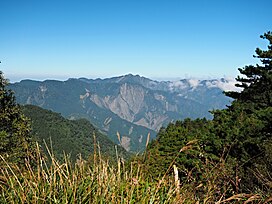Mount Data
| Mount Data | |
|---|---|
 Mount Data in the far distance (mid-center) | |
| Highest point | |
| Elevation | 2,310 m (7,580 ft)[1] |
| Coordinates | 16°53′0″N 120°50′48″E / 16.88333°N 120.84667°E |
| Geography | |
| Country | Philippines |
| Region | Cordillera Administrative Region |
| Province | |
| Parent range | Cordillera Central |
Mount Data is a mountain located in the Cordillera Central mountain range rising to a height of 2,310 metres (7,580 ft) in the north of Luzon Island, Philippines.[2] It is about 100 kilometres (62 mi) north of Baguio on the borders of the provinces of Benguet and Mountain Province along the Halsema Highway.[3][4] The mountain and surrounding area has been declared a National Park since 1936. In 1940 the park was expanded to 5,513 hectares (13,620 acres).[5][1] The slopes of the mountain are covered with pine forests and mossy oak forests.[4]
Fauna
Mount Data is formerly known for its great biological diversity and is a place that has long been in the attention of biologists. In 1895, the Englishman John Whitehead gathered a vast collection of mammals and birds from the mountain. This mammal collection was then donated to the British Museum. A research by renowned zoologist Oldfield Thomas showed that many unknown species inhabit the area. Half a century later, a large collection of small mammals was collected by an expedition led by the Filipino biologist Dioscoro S. Rabor.[6] Some of these mammals are Carpomys melanurus (short-footed Luzon tree rat) and Carpomys phaeurus (white-bellied Luzon tree rat). In addition to several rare species of mammals, there are also some bird species like the Collocalia whiteheadi (Whitehead's swiftlet) which was only known then from a specimen that was caught during the expedition of John Whitehead on the mountain.[7]
See also
References
- ^ a b Cairns, Malcolm, ed. (2017). Shifting Cultivation Policies: Balancing Environmental and Social Sustainability. CABI. p. 720. ISBN 1786391791. Retrieved 22 February 2019.
- ^ "Mount Data | Protected Planet". Protected Planet. Retrieved 2018-04-22.
- ^ Grele, Dominique; Jouve, Lily Yousry (2004). 100 Resorts in the Philippines: Places with a Heart. Asiatype, Inc. p. 77. ISBN 9719171979. Retrieved 22 February 2019.
- ^ a b "Mt. Province Travel Information". Asia Travel. Archived from the original on 7 May 2001. Retrieved 22 February 2019.
- ^ Perera, Jayantha (2009). Land and Cultural Survival: The Communal Rights of Indigenous Peoples in Asia. Asian Development Bank. p. 71. ISBN 9292547135. Retrieved 22 February 2019.
- ^ Losing Diversity and Courting Disaster: The Mammals of Mt. Data National Park door Lawrence R. Heaney, Danilo S. Balete, Joel Sarmiento, en Phillip Alviola, Haribon.org Retrieved 13 June 2007
- ^ Heaney, Lawrence R.; Balete, Danilo S.; Rickart, Eric A. (2016). The Mammals of Luzon Island: Biogeography and Natural History of a Philippine Fauna (illustrated ed.). JHU Press. pp. 5–7. ISBN 1421418371. Retrieved 22 February 2019.


